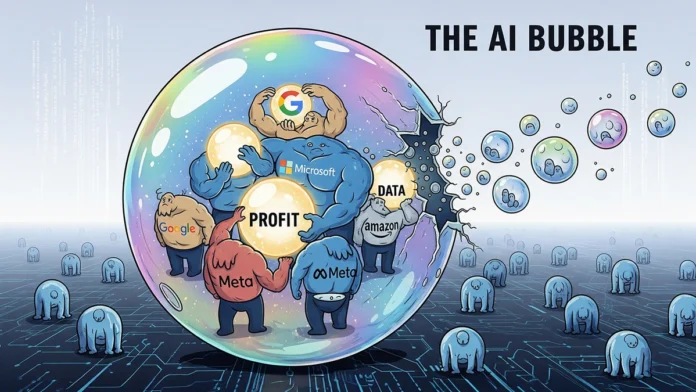Silicon Valley is buzzing, not just with the usual tech optimism, but also with a creeping sense of unease: an AI Bubble . Deals are still happening, funding rounds are closing, and new AI-powered startups seem to pop up daily. But behind the scenes, whispers of inflated valuations and unsustainable growth are getting louder. Here’s the thing: this isn’t just about money; it’s about the future of a technology that promises to reshape our world.
Why This Time Feels Different – The Context Matters

We’ve seen bubbles before. The dot-com boom, the housing crisis each had its own unique set of circumstances, but they all shared a common thread: irrational exuberance. This time, the excitement is fueled by the very real potential of artificial intelligence . But potential doesn’t always translate to profit, and that’s where the worry sets in.
What fascinates me is how quickly AI has gone from a niche field to the darling of the investment world. A few years ago, AI was the realm of PhDs and research labs. Now, every company, from your local grocery store to multinational corporations, is trying to incorporate AI into its operations. And that demand is driving up valuations, sometimes to levels that seem detached from reality. The fear, of course, is that many of these companies won’t be able to deliver on their promises, leading to a painful correction.
Decoding the Deal Frenzy – What’s Really Going On?
So, what’s driving this intense deal activity? Several factors are at play. First, there’s the fear of missing out (FOMO). Investors don’t want to be left behind if AI truly becomes the next big thing. Second, there’s a genuine belief that AI can solve some of the world’s most pressing problems. From healthcare to climate change, AI offers the potential for breakthroughs that could dramatically improve our lives. And third, there’s a lot of hype. The media is constantly touting the transformative power of AI, which only adds fuel to the fire.
But let’s be honest: not every AI startup is created equal. Some are built on solid foundations, with innovative technology and a clear path to profitability. Others are simply jumping on the bandwagon, hoping to cash in on the hype. As per the article published inCB Insights, the funding for AI startups has increased more than 200% in the past two years. The challenge for investors is to distinguish between the real deals and the overhyped ones.
The Indian Angle – Opportunities and Risks
For India, the potential AI bubble presents both opportunities and risks. On the one hand, India has a vast pool of talent and a growing tech industry, making it an attractive destination for AI investment. Indian startups are already making significant strides in areas like AI-powered healthcare and education. But, on the other hand, India also faces the risk of being caught up in the hype, leading to misallocation of resources and ultimately, disappointment. India’s tech companies can leverage Intel AIto push AI adoption.
The key for India is to focus on building a sustainable AI ecosystem, one that is based on real-world needs and a long-term vision. This means investing in education and training, promoting research and development, and fostering collaboration between industry, academia, and government. It also means being realistic about the limitations of AI and avoiding the temptation to chase short-term gains at the expense of long-term sustainability. In addition, Indian firms have the opportunity to work with AMD AI chipsas they continue to build momentum.
Navigating the Uncertainty – A Guide for Investors and Entrepreneurs
So, how do you navigate this uncertain landscape? If you’re an investor, it’s crucial to do your homework. Don’t just invest in a company because it has the word “AI” in its name. Dig deeper. Understand the technology, the business model, and the team behind it. Ask tough questions. And be prepared to walk away if the answers don’t add up.
If you’re an entrepreneur, focus on building a real business, not just a cool technology. Solve a real problem. Create a product that people actually want to use. And be realistic about your growth prospects. Don’t get caught up in the hype. Remember, sustainable growth is always better than a meteoric rise followed by a crash.
I initially thought this was just another story about inflated valuations, but then I realized it’s about something much bigger: the responsible development of a technology that could change the world. The AI bubble is a reminder that progress isn’t always linear. There will be ups and downs, booms and busts. But if we approach AI with caution, foresight, and a healthy dose of skepticism, we can avoid the pitfalls and unlock its true potential.
Beyond the Hype | The Future of AI is…Practicality?
The future of AI, I believe, isn’t about flashy demos or impossible promises. It’s about practicality. It’s about finding ways to use AI to solve everyday problems, to make our lives easier and more efficient. Think AI-powered tools that help farmers optimize their crop yields, or AI-driven systems that can diagnose diseases more accurately. The real value of AI lies in its ability to augment human capabilities, not to replace them.
FAQ – Understanding the AI Landscape
What exactly is meant by an “AI bubble“?
It refers to a situation where investments in AI companies become overvalued, driven by hype rather than solid business fundamentals, similar to historical tech bubbles.
How can I tell if an AI company is overvalued?
Look at their revenue, user growth, and technology. Compare these metrics to their valuation. A company with little revenue but a high valuation may be overvalued.
What are some sectors where artificial intelligence is being used effectively right now?
Healthcare (diagnostics), finance (fraud detection), agriculture (precision farming), and manufacturing (automation) are all seeing real-world AI applications.
Is it too late to invest in AI?
Not necessarily. While some areas may be overhyped, there are still plenty of opportunities, especially in niche areas and long-term investments.
What skills should I learn to stay relevant in the AI-driven future?
Focus on data analysis, machine learning, programming (Python, R), and critical thinking to understand AI’s implications.
How can I protect myself from misinformation about AI startups ?
Always cross-reference information from multiple sources. Be skeptical of overly optimistic claims and look for independent verification of results.
So, while Silicon Valley might have a few jitters about an AI bubble , it’s a reminder to stay grounded, think critically, and focus on the real potential of this groundbreaking technology. It’s not just about the deals; it’s about the future we’re building. And that’s a future worth investing in – wisely.

